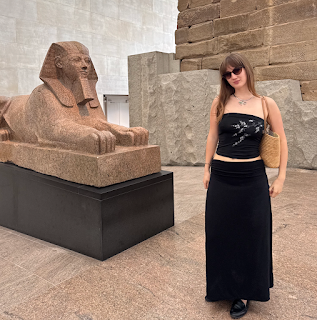Week 7: Restoration Reflections from Afar
 |
| The Sphinx and I |
Hello Reader,
This week’s blog post is a bit different. I wasn’t able to make it into the Bonnet House due to being sick and needing some time to rest. I had only planned to go in on Wednesday, since Katie was going to be out of the office on Thursday, but unfortunately, I wasn’t well enough to go in at all. Even so, I had an unexpected opportunity to think about museum work in a different context.
 |
| Some art I saw at the MET |
Over the weekend, I took a spontaneous trip to Manhattan with my mom and spent a day at The Metropolitan Museum of Art. While I saw many incredible pieces of art and historical artifacts, one stood out to me above the rest: the colossal Sphinx of Hatshepsut, located in Gallery 131 next to the Temple of Dendur.
The statue, originally from Hatshepsut’s mortuary temple at Deir el-Bahri, depicts Egypt’s first female pharaoh with the body of a lion and a human head. She wears the royal nemes headcloth, a false beard, and the uraeus cobra on her brow, symbols of kingship that assert her authority as pharaoh, not queen. The sphinx was one of at least six commissioned for her temple, and while most were badly damaged after her death (likely by order of her successor, Thutmose III), many were later recovered and restored.
The particular statue I saw was among those unearthed by The Met’s expedition in the 1920s and painstakingly reconstructed from fragments found in the Senenmut Quarry. When I stood in front of it, I was drawn in not only by the scale and power of the sculpture, but by the visible marks of restoration: subtle brush strokes, areas filled with plaster and repainted in acrylic, all blended carefully to match the original surface.
 |
| The Sphinx was reconstructed with plaster and then painted |
This stood out to me because earlier in my internship at Bonnet House, I helped restore a fragment of a wooden frame that had broken off one of Frederick’s paintings. Katie had rebuilt the form with plaster, and I used acrylic paint to color match and finish the repair. Seeing the same materials and techniques applied to an ancient Egyptian statue at The Met, on such a different scale, was incredibly meaningful. It reminded me that conservation is an ongoing conversation with the past, whether we’re working on a century-old picture frame or a 3,000-year-old statue.
Though I missed being at Bonnet House this week, I was grateful to experience a moment of reflection and connection between my work there and the broader world of museum practice.
More updates soon—hopefully from the archive room, not the couch.
Maria Formoso



Comments
Post a Comment